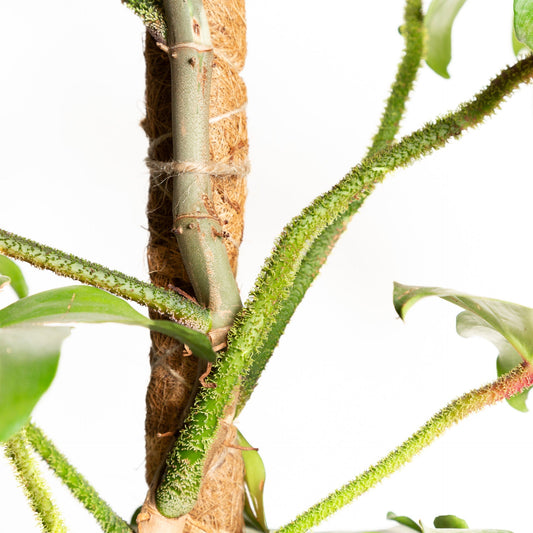An aeroid is a plant which utilizes roots that grow into the open air instead of into the soil, usually as a means to hold onto nearby objects such as tree trunks and also to pull nutrients and humidity from the air. The most well-know aeroids are philodendrons and pothos, both of which are climbing plants.
Aeroids can be a little misleading when it comes to their care - on the surface they're a beautiful and easy plant to take care of 90% of the time, but in actuality most plant parents never realize the one most critical aspect of their care: they need something to climb up or they'll never get big and they won't grow quickly! They won't die without a climbing pole and you may never notice that they're stunted, but you'll definitely notice the difference when you provide them with that climbing surface. You'll look at your plant a month later and think "geez, when did that decide to start getting so big?".
The most popular and well-known aeroids, philodendrons and pothos, are usually valued for their ease and (in the case of monsteras, specifically) for their interesting leaf patterns that can include large holes and slits in the leaves. This huge, interesting foliage readily develops in a plant because that's exactly how it wants to grow, but you have to keep in mind that these plants are all from the rainforest and grow on those massive trees that are covered in all kinds of mosses and other small foliage - that means that they're used to having something to grab onto and steal a little moisture from so that it can grow those huge leaves without falling over or snapping in half from the weight of them.
Without that structure and support, the plant chooses not to grow very large. What plant wants to grow so big that it snaps in half or falls into the dirt? Instead, it elects to stay small enough to support itself and just focus on growing as long as possible, resulting in a foliage display that's lush and long but with leaves that are never really larger than, say, the diameter of a teacup.
Enter the moss pole! This is a simple but very effective tool for growing aeroids that you'll find indispensable once you notice the results. Many plant parents are surprised that their little plants are capable of being so much larger once they implement a moss pole.
The moss on a moss pole keeps the plant wet as it grows around it and attracts its aeroid roots, which are looking for something damp to grab onto (not just any ol' surface). Dry surfaces, especially wood that hasn't been sealed, can actually dry out foliage that grows around it because it leeches moisture from the contact points, so keeping the moss on a moss pole moist is a critical element to making this work properly.
To implement, simply place the moss pole in or near the pot that your aeroid is planted in and make sure that some part of the plant (preferably any aeroid roots that are showing) is touching the moss pole directly so that the plant knows that it's actually there. After all, they don't have eyes! After that, the plant should be good to go and will naturally curl around the moss pole as it grows. Feel free to encourage it with a little strategic foliage placement if you feel that's necessary.
As with all plants, expect the most noticeable growth to take place in the spring and summer. If your aeroids are lacking a moss pole, it's our recommendation that you implement one as soon as you're able - but if that happens in the winter, just know that the really impressive growth is going to happen in the spring, and look forward to that!
If you're interested, we do carry our own selection of moss poles!



